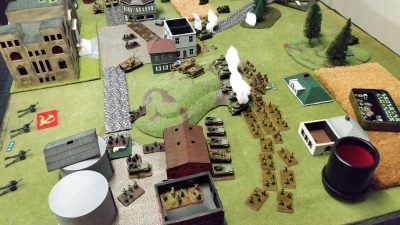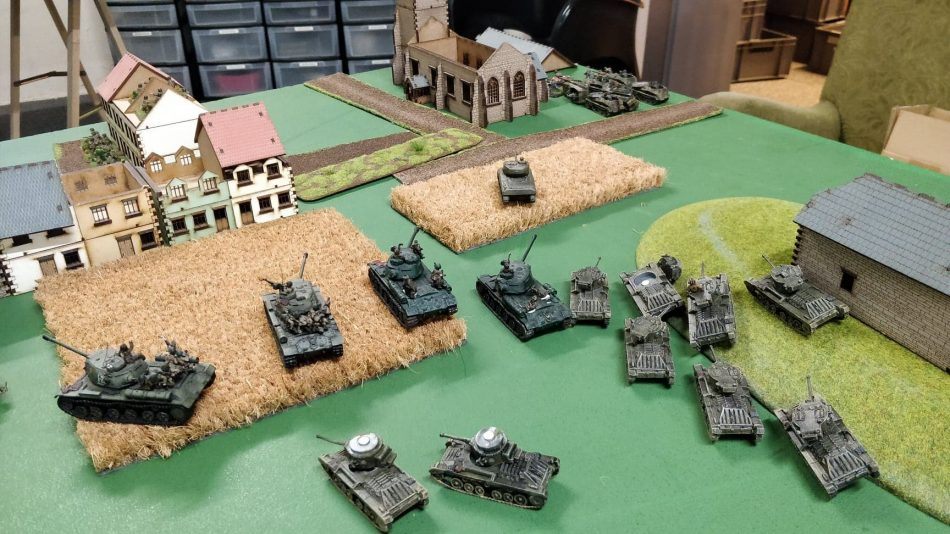Total War in Russia – Battle for Kiev 38,000 pts LW
By Benny Christiansen
I have always had a weakness for the huge battles. I love seeing the terrain setup – with a “story in mind” so to speak – and then the first few turns in the game, making the first efforts to win the battle.
In this article, I will attempt to describe how I plan the 38,000 points battle and my thoughts in the process, as well as being a tiny battle rep with pictures and video. The primary intention here is to inspire others by sharing the experience. The setting is in LW, but I believe it can be done in any of the games in FOW. I am well aware there are many other ways to do this, and I encourage anyone who finds large battles interesting, to try it. It is not the same as making a tournament. I think that an event like this is more interesting for the historically focused players than a tournament might be.
A friend of mine requested that I made a large Total War event for eight people. We based it on an online campaign I had recently ended. We agreed to make it about the city of Kiev. In the campaign, that was a Late War campaign, the German forces managed to take Kiev and hold it and, unlike Stalingrad, they held on until we stopped the campaign. In the campaign, the Russian forces tried several times to cut off the Germans, but never managed to really stop the reinforcements from arriving.
So I start out trying to find out how many points we are going to play. I tend to go big, but not too big, as it will drown out the tables and we end up spending time trying to move out of the way of our own troops. When deciding the setup, I also try to look at reserves from the beginning. In this case, I ended up deciding that we would use a variant of the Deep Reserves for both sides, combined with Scattered Reserves, in order to make sure everyone play vs everyone.
At 32,000 points in total (plus two trains) I went to the maximum, and a little above. This gives the defender a small advantage, as the defender can choose from a somewhat large array of choices to counter the attacker. Stalling the attacker is a good way for the defender to prevent a rush victory, where the attacker has 15 IS2 tanks charging into the defender.
Information for me, with all relevant information.I always make two setups, one for each side, and also one for me as TO. I find that it helps me staying in control and being able to see the situation from both sides. I often find that changes to the setup are needed up to the day of the battle, and I subsequently send out regular updates to each side, with a new setup.
In this situation, I had been asked if it was possible to permit the use of large amounts of T34s. I had a discussion with the General of the German team. When dealing with such large point sizes, it is rarely interesting to talk about a single Special Character or similar, but potentially 80+ T34s could ruin everyone’s day. We changed the setup so the Russians would be unable to be aggressive on the lower table and made it into a “Meeting Engagement” while the rest was equivalent to Cauldron setup (not reserves etc).
The German players enjoyed their armored trains, so we made it so they had two of them, and ended up making them primary objectives for the Germans so they would win a tactical victory if both of them reached the city.
The three “legs” of the tableThe Final Briefing
After several months of preparations and discussions, we were ready to go. The setup was as follows:
- Two sides; German and Russian. Grey Wolf and Red Bear
- 3000 points for two players and 4000 points for eight players. The two players with 3000 points were late add-ons and I decided it would be too much to change the entire setup. So I chose to make them come in from Reserves with 60% of their list in turn 1, and 40% in turn 2. It would be scattered reserves for them and for most of the players, except on the “Train Table”
- Any lists would be allowed. SC would be allowed after contacting me. It would be required that ALL combat choices had been used before you could buy any other support of formation/list (other well-tested ways of doing this are to force players to bring all combat choices, but only choose support from one list/formation.) This way there will be fewer support choices such as KV8’s and more “core choices” making them feel more “historical” for most players).
- The Russians could gain points by:
- Having a team in a building in the enemy deployment zone, based on the Fog Of War card “Setup forward HQ” (2 points per turn)
- Precise attack: Every time a Luchs choice or Rocked Launcher choice was destroyed, gain 1 point
- Dual Objective: Based on the Fog Of War card. Pick a point 40 cm away from your deployment zone and place one objective within 60 cm from it. The opponent does the same.
- Holding ordinary objectives: each objective would be placed with appx 40 cm space between them and a maximum of 20 cm from the German table edge. Holding 3 of these for two turns in a row. 1 objective gains 1 point per turn.
- Taking out a huge cannon on the train 1 point

- The Germans could gain points by:
- Getting a train into Kiev. One train = +50% points to the points they have at the end of the game. Two trains = tactical victory
- Precise Attack: Every time 1 T-34 platoon would be destroyed gain 2 points.
- Holding objective: The Germans had two objectives they could take (most likely) by attacking out of Kiev. Each objective would give 5 points.
We had planned to play on seven tables, but unfortunately, a minor change had to be made, and we played on appx 6 tables. I have never had an event, where everything went as planned, so we adapt, adjust and overcome the problems.
The Battle
A battle that is this big, is rather hard to summarize up, to the extent that it provides a reader with the full sensation of understanding the event. I will give it a try, though.
Deployment
It came as a surprise to some of the players, that they only had a few minutes to set up. The German players had 10 minutes to set up fortifications, and later 6 minutes to deploy their 4000 pts forces. The Russian players had three. I managed to deploy my Spetznaz and then gun teams, but it was not in an optimal position, as I only had 1 infantry position to shoot at. My infantry HQ however, was pretty close by. I placed my artillery and then my 3 minutes were gone. I had to take three Strelkovy blobs in reserve.
The Trains
The Trains and the table where they deployed was a total bug-down. I could have realized this many times in the progress of the preparations, as I know it is too many points. But I also believed that artillery would quickly remove all the stationary units, combined with air attacks.
One of the German trains after deployment
As it turned out, sustained artillery, air and direct shooting did not make a safe passage through the Russian hordes possible. I asked the German players if a thrust forward, surrounded by
Turn 3smoke, could have made it possible for them to break through, but they seemed certain it would not be possible. The 4 players, all in all, 16.000 points ended up grinding each other to a halt. The German players in Kiev did not make an attack down towards them, as I had assumed, and that meant the Russian players had the initiative in that area.
The U-shaped table
On the “U” shaped part of the table, the German players had deployed 2 King Tigers at the very top of the tables west side. This was in part due to scattered reserves. I also think they deployed at the very northern end of the deployment zone, making it difficult for the slow-moving tanks to participate in any other part of the battle.
On the eastern part of the table, to the north, the Germans had a much better defense. They had a mix of infantry/mechanised and gun teams and later in the game, also some standard tanks and recon vehicles.
Turn 3Important lessons learned
- Scattered Reserves worked as intended. It made players play all opponents on the U shaped table. General satisfaction with that part.
- Germans unable to penetrate Russian defense. The one table with so many points is just not fun.
- Setup: Too many participants find it difficult to keep up with changes. In future, less information is better. People forget, ignore or don’t even read information. Better to give info on list restrictions only, or with a very minimum amount of information about the setup. The setup specifics seems to have very little effect on the lists of this size (people tend to bring what they have)
- Spend time at the startup of the day to go through the missions.
Turn 3

OT34s ending their days attempting to get close to the objective to the left in the picture.
The Trains were stopped, and the forces were too many at the Train Table, unfortunately. But many tanks, infantry and gun teams gave their lives to teach us this lesson.
A T34 assault supported by Russian strelk. But the IS2s were already there to take out the bunker and pak40’s
Video reports
If you press the CC button in the videos, there should be a chance that you can read what I am trying to say. Lots of background noise.
A brief welcome video.
German players set up their forces
Turn 2 recap
Turn 4

Great set up and game mechanics. Valuable Lessons Identified. I would love to discuss details for a repetifion here in the Netherlands. My email address is sybren02@hotmail.com
Hello. I have contacted you on the mentioned email.
Thank you for your comments 🙂